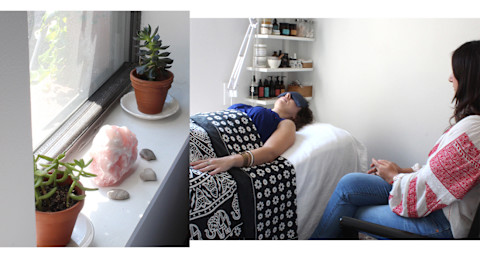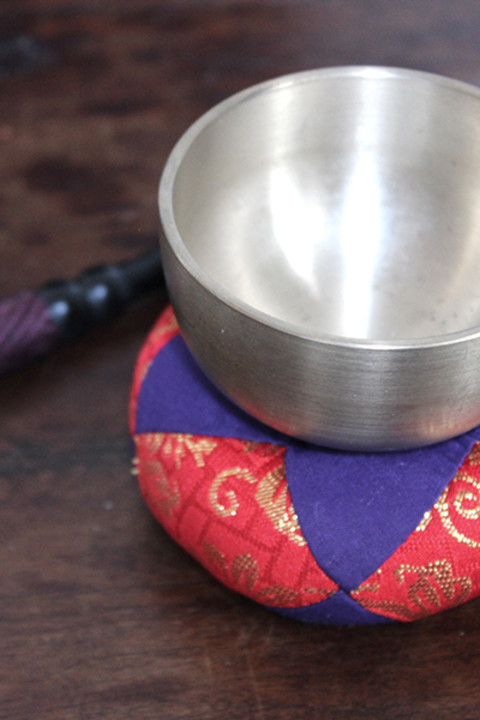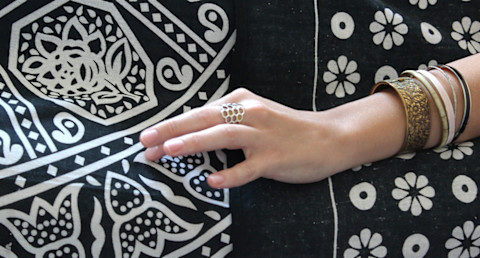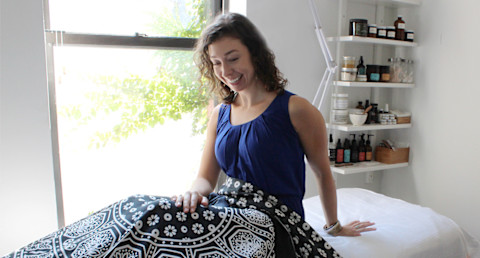

I'm lying on a massage table in a dim little room somewhere in the middle of Brooklyn's hip Greenpoint neighborhood as my hypnotist, Morgan Yakus, instructs me to take a series of deep breaths. "Now, focus your eyes on a point on the ceiling," she says. "Keep staring at that point until you feel your eyelids get heavy, then let them close when they want to. Take your time."
I lie there breathing and eventually let my eyelids flutter closed. She places a lavender-scented pillow over them and begins to talk me deeper into relaxation. "Allow yourself to really let go," she says. "You're in a safe space." As she continues guiding me deeper into this relaxation, my perpetually tense muscles slowly release and I begin to feel that floating, almost twitchy just-about-to-fall-asleep sensation. Then, she starts to ask me questions.
"Do you remember the first time that you felt anxiety?" she asks. "Oh, I was at a sleepover at a friend's house in second grade," I answer without hesitation. My voice is deeper, more resonant, as I describe said friend's terrifying pet guinea pig. My subconscious brain couldn't be more certain of my responses, while my rational, conscious brain is thinking, Huh?! But I press on, recalling minute details of a memory that until this very moment had been completely forgotten. That's when I realize that I've most definitely been hypnotized.

These days, hypnosis is gaining popularity for its ability to help treat everything from addiction to emotional trauma. "The process of hypnosis essentially involves leading someone into a trance state for the purpose of resolving an issue they are dealing with, whether it be physical or mental," says Dr. Maryanna Polukhin, an internist who incorporates hypnosis into her medical practice (she's also on the executive board of the American Society of Clinical Hypnosis). And while words like "trance" or "hypnosis" make the whole thing sound very New Age, Polukhin is quick to explain that it's actually not that out-there. "Research shows that the average person goes into a trance state many times throughout the day," she explains. "It's just a state of profound concentration, where your surroundings melt away. So when you play a game on your phone and don't notice a full hour pass by, that's trance." Hypnosis makes use of that state to enact change. And it seems to work: Research has linked hypnosis with relief from chronic pain and irritable bowel syndrome, smoking cessation, and the treatment of phobias.
Willing Yourself Well

Hypnosis is the oldest Western form of psychotherapy, but the research is still catching up to anecdotal reports of the method's success. In short: There's no consensus on how it works. Some argue that the hypnotic state is the result of the power of suggestion — someone is told that they'll be hypnotized, so a few minutes later, they believe they have been. But a small, recent study from a group of Stanford researchers suggests hypnosis sparks real changes at a brain level. Using functional magnetic resonance imaging, the team evaluated subjects' brains in a normal state and during hypnosis. During hypnosis, there were significant changes in activity across parts of the brain involved in attention, muscle function, and environmental awareness. "Hypnosis ... is a very powerful means of changing the way we use our minds to control perception and our bodies," lead researcher David Spiegel, M.D., said in a statement. "Now that we know which brain regions are involved, we may be able to use this knowledge to alter someone's capacity to be hypnotized or the effectiveness of hypnosis for problems like pain control."
"The state of calm you achieve in hypnosis would take years to master with meditation."
Debate aside, hypnosis seems to work by helping you relax and quiet your conscious mind so that you can be guided to a resolution for the problem you're facing. Once you've gotten to the root of a problem or bad habit, the hypnotist may ask you to mentally have a conversation and clear the air with whatever person in your life it's about, or she might speak directly to your subconscious, telling it that it's safe to let go. "It's about changing the patterns in your mind," says Yakus. "So if you're stressed or stuck in a habit and you feel like you can't move forward, I help you change that pattern so that you see things in a different way." Hypnosis literally creates new pathways in the brain, she adds: Now, when you head to the fridge or think about that can't-get-over-him ex, your brain hurtles down a new, healthier track, so you don't automatically complete the bad habit. And as you release these emotional or mental blocks, you can create physical healing, too. Hypnosis practitioners say that it's not unusual for patients to recover from chronic pain, illness, or major injuries after a successful session.

Yes, a single session. What's especially impressive about hypnosis is that, unlike other therapeutic modalities (such as meditation or traditional talk therapy), you might notice significant shifts after just a session or two. "The process of hypnosis feels like meditation," Polukhin says, "but the state of calm you achieve in hypnosis would take years to master with meditation." The treatment's speed, she explains, boils down to people's desire to trust a professional and take the pressure off themselves. "When I tell people, 'I'm a doctor and I can help you, you're safe and you just need to follow my instructions,' the fear really melts away — and it's absolutely miraculous what happens afterward,” she says.
Care to Trance?
Of course, hypnosis is nothing new. Its origins can be traced back to civilizations, from Ancient Greece to Egypt, and the tradition of "sleep temples." Inside these old-school houses of hypnotism, priests assisted visitors in inducing a dream state, and then interpreted their dreams. Other cultures, from the Aztecs and Mayans to the Native Americans used (and in some cases, still use) tools like drumming, chanting, and dance to induce the trance state and access the spirit worldLately, though, it's the practical applications that are drawing more and more fans. Since hypnosis gives direct access to the subconscious mind and deeper memories, it can essentially allow you to resolve lingering issues and reprogram ingrained habits. Celebrities like Matt Damon and Ellen DeGeneres have openly spoken about their experiences employing hypnosis to help them quit smoking. Likewise, Orlando Bloom reportedly turned to hypnosis to get over a childhood chocolate addiction while Kate Middleton is said to have used the technique to overcome her morning sickness and aid with pain management during childbirth (there's even a name for the practice: hypno-birthing).
"My relationship with my desires and fears quickly changed in a really positive way."
Hypnotists like Yakus have noticed the shift, too, citing a significant uptick in inquiries and new patients to their practices. It's likely that our newfound openness as a society to "alternative healing" (think: acupuncture, energy healing, integrative medicine, and the like) has something to do with it, too. "As more people experience transformations during hypnosis and are willing to share those experiences, the practice grows by word of mouth," Yakus says.
What hypnosis is decidedly not? It's not anything like the pop culture depiction of the practice. "I hate the whole stage hypnosis thing," says Michelle Brock, an NYC-based hypnotist who specializes in past-life regression hypnosis (a particularly popular hypnosis practice that involves accessing and releasing memories from previous lives). "It's presented as someone having mind control over another person. The truth is, nobody can control your mind or make you do something that you don't want to do.” Those stage performances are mainly a hoax, with the so-called hypnotist selecting the most suggestible audience members who are dying to participate in the performance. A friend who was once chosen for one of those gigs openly admitted to me that she faked it. "I just didn't want to be the only one who couldn't do it, so I pretended to zonk out," she recalls.
Oh, and as for Jafar from Aladdin and his mind-controlling snake staff (yes, I asked), Brock explains that his technique was based in real traditions (an ancient technique in which monks and other practitioners stared at an object in order to quiet the mind), but his powers were wildly exaggerated. Same goes for that mind-control sequence from Zoolander. In a real-life hypnosis session, nobody will manipulate your brain or make you say or do crazy things. It's not about mind control; it's a safe and gentle way to help facilitate mind change.
Shortcut to a Shift

In fact, Jenel Chesley, one of Yakus' clients, describes her hypnosis experience as oddly similar to regular old therapy. "It was surprising to me that after trying various methods of healing, from the traditional to the very alternative, hypnosis felt the closest to therapy, but with much quicker results," she says. "Even after just one session, I felt lighter and unburdened. My relationship with my desires and fears quickly changed in a really positive way."
Actress Alyssa Diaz, another Yakus devotee, says she fell for hypnosis because it's just so simple. "It helped me to achieve my goals by breaking them down into small, actionable steps, which released my fear and tendency toward procrastination," she says. "With the help of hypnosis, I became a vegetarian, lost 15 pounds, gained freedom and happiness in my work, and established joyful communication with my father."
Best of all? You'll need to enlist a professional hypnosis practitioner for the big shifts, but you can also hypnotize yourself for a little mental boost between sessions. Yakus teaches a self-hypnosis practice (you can find instructions here) that you can practice anywhere from your cubicle to your morning subway commute (it'll make both of those places far more pleasant, too). Because as hypnotist Michelle Brock says, "Hypnosis is really about showing people that they have the power to heal themselves. All the answers lie within. We just guide you there."
